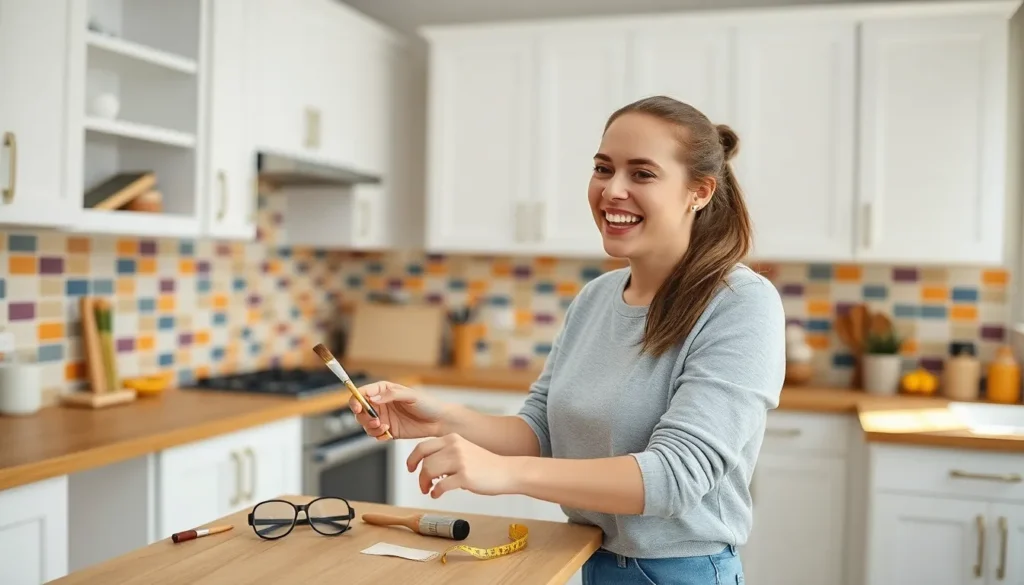Table of Contents
ToggleThe kitchen is the heart of the home, but let’s face it—it could use a little love. If those outdated cabinets and lackluster countertops are making you cringe, it’s time to roll up those sleeves and unleash your inner DIY guru. Transforming your kitchen doesn’t have to mean breaking the bank or hiring a small army of contractors. With a dash of creativity and a sprinkle of elbow grease, anyone can whip up stunning upgrades.
From quirky backsplash ideas to clever storage solutions, DIY kitchen projects can breathe new life into your space. Not only will you impress your friends with your newfound skills, but you’ll also have a kitchen that reflects your unique style. So grab your tools and let’s dive into a world where creativity meets functionality—because who said home improvement couldn’t be a little fun?
Overview of DIY Kitchen Projects
DIY kitchen projects infuse creativity into home improvement. Transforming the kitchen enhances both its aesthetic and functionality.
Benefits of DIY Kitchen Projects
Cost savings stand out as a primary benefit. Tackling projects without professional help reduces expenses significantly. Increased personalization follows closely behind, as individuals can tailor their designs to reflect their unique styles. Satisfaction from completing projects boosts confidence in one’s skills. Learning new skills often occurs during the process, as individuals gain valuable experience in different techniques and tools. These projects also foster a sense of accomplishment, making the kitchen feel more like a personal space.
Popular DIY Kitchen Project Ideas
Many kitchen projects capture interest, providing ample opportunity for creativity. Updating cabinet hardware emerges as a simple yet impactful way to refresh a kitchen’s look. Adding a backsplash creates an eye-catching focal point, enhancing both style and practicality. Building custom shelving maximizes storage space effectively, accommodating various kitchen items. Painting cabinets provides a dramatic change without significant investment, breathing new life into dated finishes. Crafting a kitchen island serves as a functional centerpiece, allowing for additional workspace and storage.
Essential Tools and Materials

Gathering the right tools and materials is crucial for successful DIY kitchen projects. These items make the process smoother and ensure better results.
Basic Tools for DIY Kitchen Projects
Measuring tapes help achieve accurate dimensions for new installations. A level ensures that shelves and cabinets align correctly. Screwdrivers, both flathead and Phillips, assist in disassembling and assembling fixtures. Utility knives are essential for cutting materials like trim and wallpaper. Drill drivers allow for efficient installation of screws in various surfaces. Clamps stabilize materials during assembly. Safety glasses protect eyes from debris during cutting or drilling. Finally, a paintbrush or roller provides the finishing touch on painted surfaces.
Recommended Materials for Kitchen Upgrades
Plywood offers a sturdy base for shelves, cabinets, and kitchen islands. For backsplashes, ceramic or glass tiles provide both durability and style. Caulk and adhesive are necessary for securing tiles and ensuring water resistance. Paint for cabinets should be durable, with options for semi-gloss or satin for easy cleaning. New cabinet hardware elevates the look of existing cabinets. Vinyl flooring tiles improve aesthetics while offering practical benefits like easy installation. Countertops can range from laminate for budget-conscious projects to natural stone for a luxurious finish. Use wood stains to enrich natural finishes on DIY furniture.
Step-by-Step Guides for Popular Projects
DIY kitchen projects can transform any space into a functional and stylish area. Below are detailed guides on some popular kitchen upgrades.
Installing a BackSplash
Start by selecting tiles that match the kitchen’s style. Gather necessary supplies such as adhesive, grout, and spacers. Measure the area where the backsplash will be installed, cutting tiles as needed to fit corners and edges. Apply adhesive to the wall, then press tiles into place, ensuring even spacing. Allow the adhesive to set according to package instructions, then mix grout and fill gaps between tiles. Wipe away excess grout with a damp sponge before it dries. In approximately 24 hours, seal the grout to increase moisture resistance.
Refinishing Cabinets
Begin by removing cabinet doors and hardware for easier access. Clean all surfaces thoroughly to remove grease and dust. Sand the cabinets lightly to help the new finish adhere better. Apply primer to prevent old colors from bleeding through, followed by your choice of paint or stain to achieve the desired look. When the finish dries, reinstall doors and hardware, ensuring everything aligns correctly. This project typically yields impressive results and enhances the kitchen’s overall aesthetic.
Creating a Kitchen Island
Select a location that offers ample workspace. Use cabinets or plywood for the island’s base, ensuring it aligns with existing countertops. Secure the structure with screws for stability. Install a countertop that complements the kitchen’s design, considering materials such as wood or granite. Include additional shelves or storage options in the island for extra functionality. When finished, the kitchen island will serve as a practical centerpiece for cooking and dining activities.
Safety Tips for DIY Kitchen Projects
Safety plays a crucial role in any DIY kitchen project. Proper precautions prevent accidents and ensure a smooth workflow.
Always wear safety glasses to protect eyes from dust and debris. Use gloves when handling sharp tools or materials to avoid injuries.
Maintain a clean and organized workspace. Clutter creates hazards that can lead to slips or falls.
Ensure proper ventilation when using paints or adhesives. Fumes can pose health risks, so open windows or use fans to circulate air.
Read instructions for tools and materials carefully. Understanding the usage helps prevent mistakes that could lead to injuries.
Check for electrical or plumbing systems before starting any project. Knowing the layout helps avoid accidental damage or power outages.
When using ladders, position them on stable surfaces. Keep tools nearby to minimize stretching, which can lead to loss of balance.
Stay focused on tasks and avoid distractions. Engaging in conversations or using phones while working can result in accidents.
Keep a first aid kit accessible in case of minor injuries. Having supplies ready allows for quick treatment if needed.
If lifting heavy items, use proper techniques. Bend at the knees and lift with legs to reduce strain on the back.
Following these safety tips ensures that DIY kitchen projects go smoothly and efficiently, enhancing the experience and results.
Embracing DIY kitchen projects can lead to remarkable transformations that reflect personal style and creativity. With the right tools and materials anyone can tackle projects that enhance both the look and functionality of their kitchen. The journey of DIY not only saves money but also fosters a sense of accomplishment and pride in one’s home.
By following safety guidelines and taking a thoughtful approach to each project, individuals can create inviting spaces that serve as the heart of their homes. Whether it’s updating hardware or building custom shelves, each effort contributes to a kitchen that’s uniquely theirs. So why not take the plunge and start a DIY project today? The possibilities are endless and the rewards are truly satisfying.



